The problem of reducing heating costs today comes out on top for many categories of citizens. It especially affected the owners of private houses with an individual heating system, sewerage and water supply. Very often, pellet boilers are a smart solution to reduce costs.
Pellet boiler Ekoret from VIADRUS with a fuel bunker
Boilers of this type have only recently become widespread in the homes of Russians, but due to the low price, low cost of fuel and ease of maintenance, they are increasingly being installed for space heating. Below we will consider the design features and the principle on which pellet boilers work. The customer reviews that are given in the article will help evaluate the pros and cons of buying a pellet pyrolysis boiler.
Pyrolysis
Pyrolysis is the decomposition of organic compounds at high temperatures. With the access of oxygen, the pyrolysis process turns into ordinary combustion. If the access of oxygen is limited, then the hydrocarbon fuel will decompose into low molecular weight combustible compounds and slag. In the case of wood pyrolysis, a mixture of gases of methyl alcohol, acetone, benzene and a small amount of other combustible substances and almost pure carbon with impurities of metal oxides is formed.
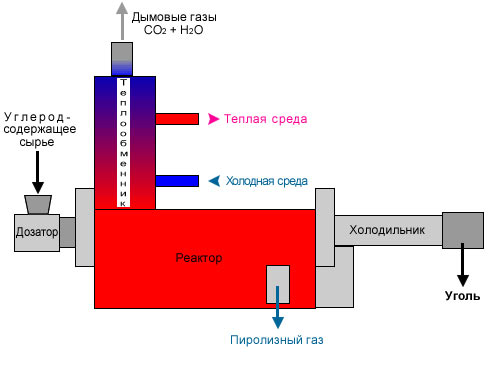
More recently, charcoal has been widely used as a fuel - a fuel that is obtained by burning wood without access to air in coal pits. Such a traditional one leads to significant losses of thermal energy during primary combustion. A modern solid fuel pellet boiler is devoid of this drawback and is able to fully use the thermal energy that is generated during the pyrolysis of wood. Therefore, such a device is also called a gas generator.
The principle of operation of the boiler on pellets
Long-burning pellet boilers consist of three separate mechanisms:
- directly from the boiler with a burner;
- conveyor for feeding granules;
The pellet boiler operates as follows:
- pellets are loaded into the fuel bunker;
- pellets are fed into the boiler by a screw conveyor;
- pellets burn in the boiler furnace and heat up the coolant.
Pellet boilers use the top-down principle of fuel combustion. At the same time, combustion is much slower than in a conventional furnace, where the fuel burns “from bottom to top” and the circulating heated gas flows involve layers of fuel that are higher in the process. Structurally, this is solved as follows.
In the furnace itself there is a burner with a nozzle for supplying heated air directly to the combustion zone. Thanks to this, it becomes possible to control the rate of fuel combustion by moving the fire zone gradually down. The supply of heated air makes it possible to burn the fuel in the most complete way. At the same time, ash and soot are formed in a minimal amount, and the efficiency (efficiency factor) of boilers operating on pellets increases to 96%.
This mechanism of operation ensures the gradual combustion of fuel. Boilers of long burning on pellets can work on one tab for more than a day, which makes this equipment quite convenient for household use. In addition, the presence of a fuel bunker in the equipment design makes it possible to automate the operation of heating equipment as much as possible.
Construction and internal arrangement
The boilers are similar in design to the general scheme by which all solid fuel boilers are manufactured. However, they have some features. For example, the size of the furnace for these models is much smaller, since their heat exchanger is heated not so much by an open flame, but by hot air in the convection channels. This allows more complete use of thermal energy. The temperature of the exhaust gases in equipment of this design usually does not exceed 150 degrees Celsius.
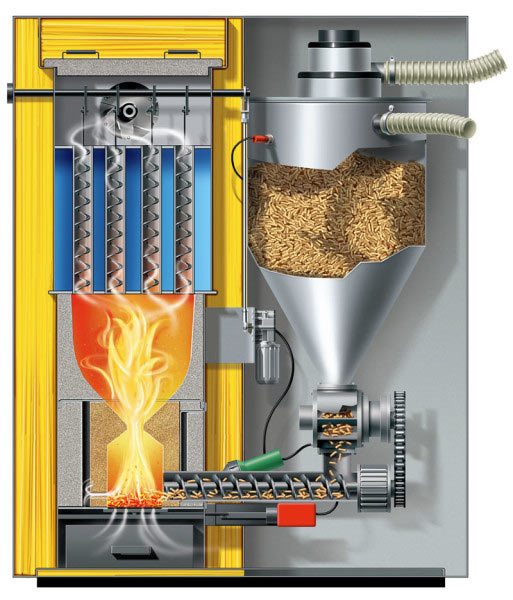
The furnace of the pyrolysis boiler on pellets is designed with the calculation of the possibility of controlling the air supply to it. The presence of a fuel bunker allows you to control the supply of pellets to it with the ability to adjust the speed and temperature of combustion. Due to this, it is possible to control the heating temperature of the coolant in the system. Structurally, this is solved by installing a screw conveyor, which directly supplies fuel.
For the manufacture of boilers for heating on pellets, high-strength steel alloys are most often used. The furnace and heat exchanger are made of corrosion-resistant cast iron. It should be noted that the service life of cast iron boilers can reach 45 years, which is much longer than the performance of equipment made of steel.
Pellet granules are ignited with the help of a special electric heating element. Air is blown into the furnace by a fan. After the equipment enters the operating mode, the electrical circuit is turned off. Thus, pellet boilers consume very little electricity.
Automatic operation
Modern models of long-burning pellet boilers are necessarily equipped with automatic equipment that feeds pellets into the furnace according to a certain program, and also turns the burner on and off to save fuel consumption and maintain a given temperature regime, which can change during the day. The control panel is located on the boiler itself or on the remote control.
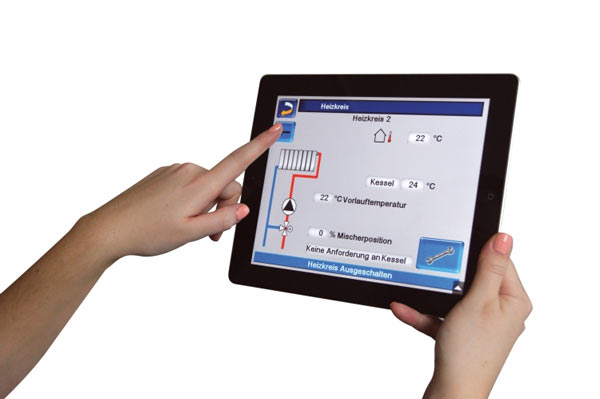
A medium-sized 25 kW pellet boiler with a fuel consumption of approximately 5 kg of fuel per day is equipped with a hopper with a volume of 250 to 350 liters. Thus, continuous fully automatic operation of the equipment can be carried out for at least three days. With the installation of an external hopper, this time can be further increased.
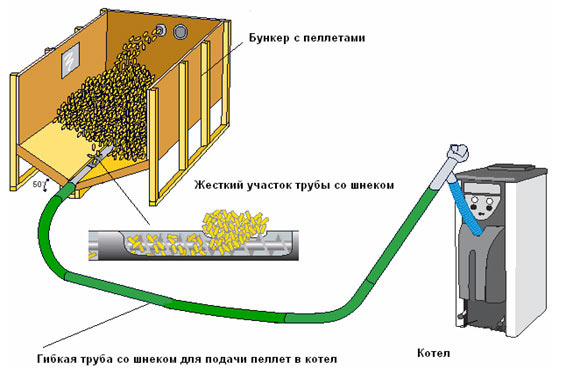
Construction of the outer bunker
Due to the fact that the supply of pellets to the boiler is metered, the burner does not overheat and all equipment can be turned off remotely by stopping the fuel supply. In this case, the boiler will automatically stop working after a few minutes, when the loaded dose of pellets is completely burned.
Equipment cost and customer reviews
In general, the price of solid fuel boilers is not the strongest point of this equipment. The fact is that pellet boilers are significantly more expensive, for example, gas equipment of the same capacity. Nevertheless, significant operational savings due to the availability and cheapness of fuel provide it with a high demand.
If we talk about the price level, we can cite the following data. A 15 kW Zota pellet boiler (Russian-made) costs approximately 150 thousand rubles. The price of the most powerful (with a capacity of 100 kW) is about 350 thousand rubles. The owners of these boilers note that the cost of one kW of thermal energy costs no more than 1 ruble. (subject to the purchase of fuel at a price of up to 4.00 rubles / kg).
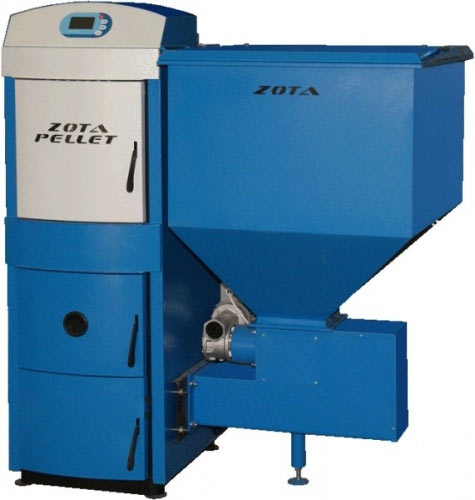
The pellet boiler Grandeg (manufactured in Latvia) with a capacity of 25 kW is sold at an average of 250 thousand rubles. A 100-kilowatt boiler from the same manufacturer will cost 500 thousand rubles.
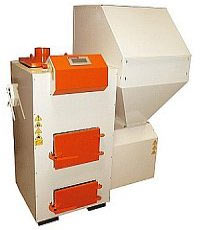
If we analyze the reviews of the owners of this equipment, it can be noted that they all confirm the significant cost-effectiveness of this type of heating equipment and ease of use. A pellet boiler house for one heating season will save tens of thousands of rubles on fuel alone.
In addition, pellet boilers are distinguished by their quiet operation and ergonomic design.
Some owners complain that this equipment needs to be connected to the mains in order to work. However, such devices consume very little electricity.
The price of pellets is about 5500 rubles per ton, i.е. one kilogram, on average, costs about 5-6 rubles. If necessary, you can set up the production of pellets by purchasing the necessary equipment or by making it yourself.
The video below shows how a pellet boiler works.
